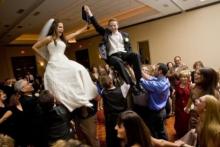The Hora is a traditional Jewish celebratory dance, common especially at weddings and at Bar or Bat Mitzvah receptions. It's a simple, inclusive and extraordinarily fun dance that has its origins in the globetrotting history of the Jewish people and perfectly reflects its dedication to community.
Like many cultural hallmarks of Jewish society we know today, the Hora grew out of the traditional exchanges that regularly took place between Jews and people of many other backgrounds during the 18th and 19th centuries. The celebratory circle dance as a form has been around for thousands of years and arose in multiple cultures, though the styles we see in Eastern Europe and the Levant descended from an ancient Greek dance whose name essentially translates as “circle” and would manifest as everything from the Balkan Kolo to the Romani Oro, and of course the many different iterations of the Hora.
The Jewish Hora is simple enough that anyone, from little children to newcomers unfamiliar with the dance, can participate with no problem, but open to enough variation that more practiced dancers can perform impressive maneuvers. The basic version of the dance has all participants holding hands in a circle and moving counterclockwise to increasingly fast, lively music. Occasionally, the circle moves inward as the dancers raise their hands in the air.
It is traditional that the sideways steps of the Hora be in a grapevine pattern (left foot stepping over the right, the right passing behind the left, then then left passing behind the right followed by the right stepping over the left) and especially athletic dancers include high kicks and jumps through an exaggeration of the grapevine.
During celebrations in which there is a guest of honor (a bride and groom at a wedding, the Bar Mitzvah at the event of the same name), that guest is traditionally lifted by at least two of the strongest dancers while sitting in a chair at the center of the circle. Other dancers may occasionally move to the center to perform more difficult and impressive maneuvers whenever the mood takes them.
The Jewish Hora is a cheerful and delightfully exhausting dance. People of any age can enjoy it and it's a great mitzvah to invite a non-Jew into the circle to share the fun as a member of the community. This is why Jewish culture embraced the circle dance. It is a dance of family and friends, and of equality. The purpose of the Hora is to create a moment of pure, unbridled joy shared among as many people as possible. As the years pass, its power to do so has yet to diminish.
